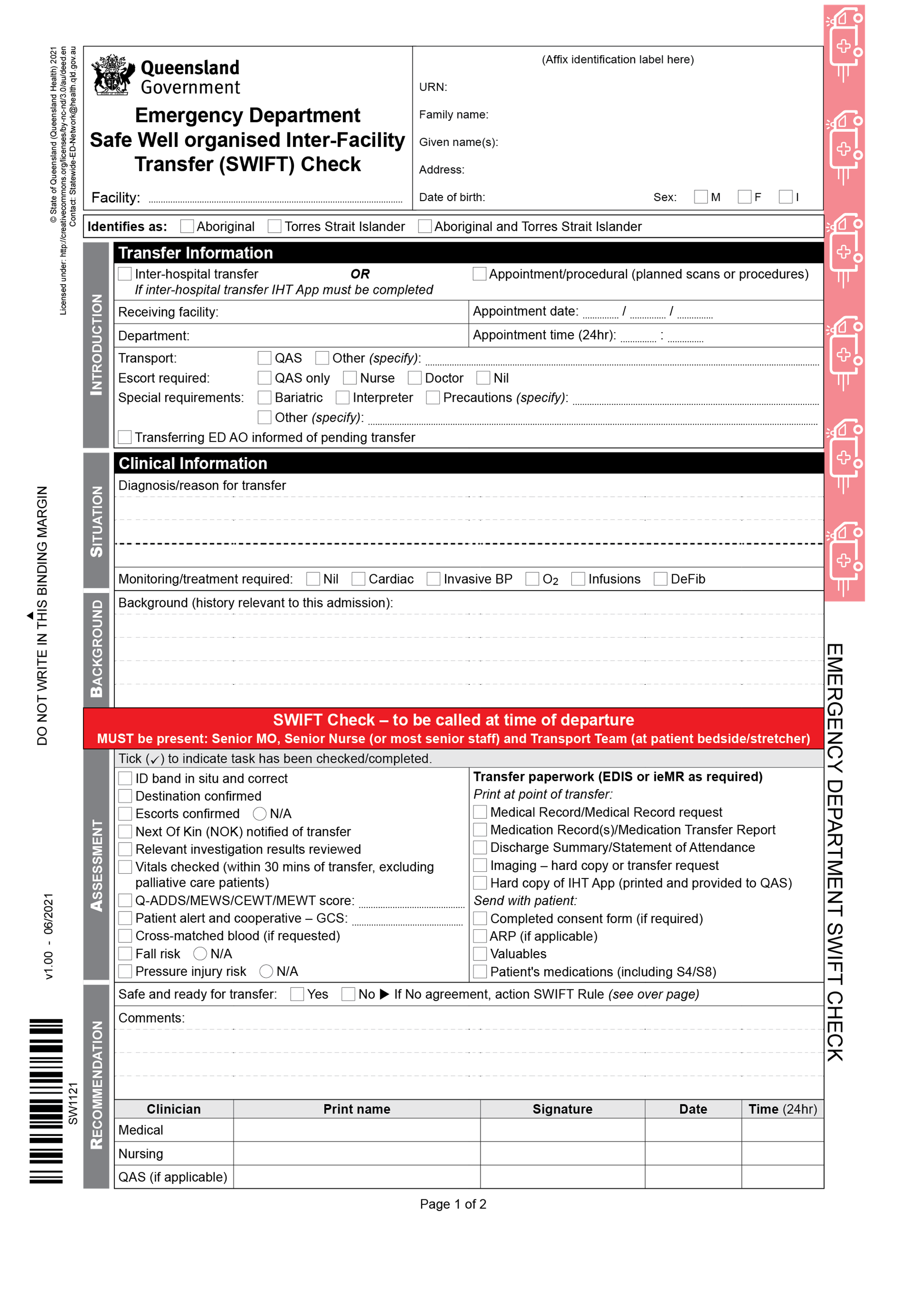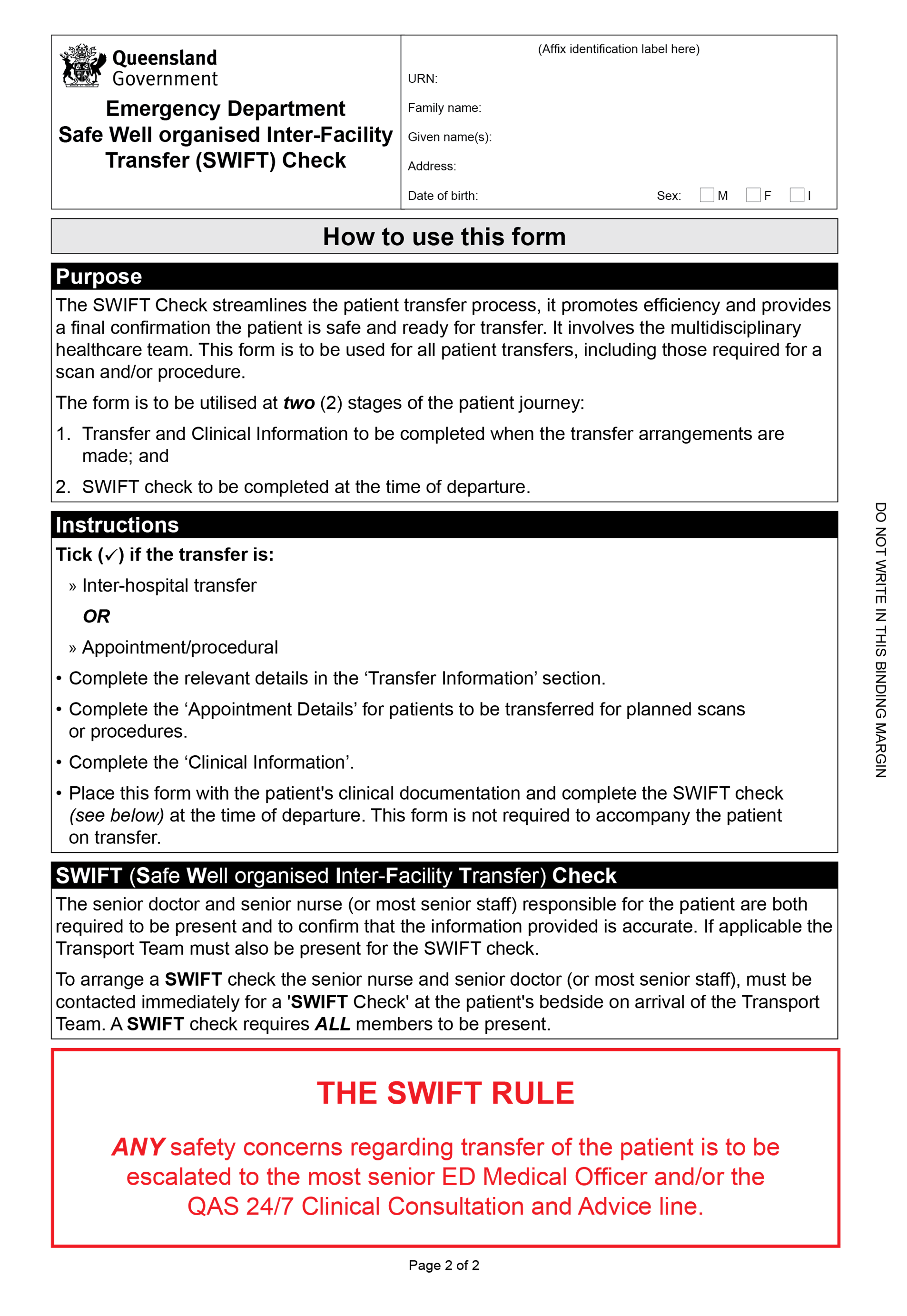Referral pathways: Major trauma (adult)
Guideline number: QH-GDL-971
Effective date: 24 January 2023
Review date: 24 January 2026
Supersedes: new guideline
- Purpose
- Scope
- Aboriginal and Torres Strait Islander Considerations
- Related documents
- Referral pathways guideline: major trauma (adult)
- Abbreviations
- Document approval details
- Version control
- Acknowledgements
- References
- Appendices
1. Purpose
Queensland Health is committed to provide timely, equitable and high-quality care for patients who suffer traumatic injuries in Queensland and Northern New South Wales. Patient retrievals and transfers following major traumatic incidents are of a highly complex and urgent nature. Clear, defined referral pathways support access to appropriate specialist care. This guideline provides recommendations regarding best practice to support referral pathways for major trauma patients across Queensland and Northern New South Wales and is intended to be used as a supplement to the Patient Access to Care Health Service Directive.(1) Appendix 1 outlines background information on the Queensland trauma system that supports this guideline.
2. Scope
This guideline applies to all employees, contractors and consultants within the Department of Health divisions, Hospital and Health Services (HHSs), prehospital care providers and clinical services involved directly or indirectly in the provision of trauma care from injury scene through to definitive care. It may be used for patients suffering major trauma where the injury occurs in Queensland or the Northern NSW Local Health District (NNSW LHD).
The Queensland definition of major trauma is an Injury Severity Score (ISS) over 12, however any significant multi-system traumatic injuries according to mechanism, injuries and physiology may follow the referral pathways contained in the guideline. It is acknowledged that the ISS may be unknown, inaccurate, or incomplete in the early stages after injury.
Paediatric trauma patients aged under 16 years are not within the scope of this guideline, however, should always be discussed with the relevant surgical consultant at Queensland Children’s Hospital (QCH) to determine the most appropriate major trauma centre for definitive care; while patients aged 16 years and over are within scope of this guideline.
Details contained within this guideline do not substitute clinical judgement, knowledge and expertise or medical advice. Clinicians are responsible for providing care within the context of locally available resources, expertise, and scope of practice. Compliance with this guideline is not mandatory, but sound reasoning must exist for departing from the recommended principles within this guideline.
3. Aboriginal and Torres Strait Islander considerations
Queensland public hospital services and staff recognise and commit to the respect, understanding and application of Aboriginal and Torres Strait Islander cultural values, principles, differences and needs when caring for Aboriginal or Torres Strait Islander patients. Each individual HHS is responsible for achieving successful provision of culturally appropriate services to and with Aboriginal and Torres Strait Islander individuals and their communities within the respective HHS catchment. Equally, the respect and acknowledgement extended to Aboriginal and Torres Strait Islander people will be extended to all participants, irrespective of ethnic background or membership of community group.
4.
Downloadable PDF: Referral pathways: Major trauma (adult) guideline
Patient access to care | Health service directive | Queensland Health
Protocol for timely transfer of care in emergency department
Protocol for management of interhospital transfers
Protocol for managing capacity of Queensland public hospitals
Retrieval services | Health service directive | Queensland Health
5. Referral pathways guideline: major trauma (adult)
5.1. Transfers for definitive care
5.1.1. Interhospital transfers should always be considered whenever a patient’s treatment needs exceed the capacity of a treating facility.(2)
5.1.2. A referral to a larger regional hospital or major trauma centre is required to enable access to the required specialty services.
5.1.3. If a statewide specialist service is needed such as burns and spinal cord injury, the recommended pathway should be followed as outlined in Section 5.4.
5.1.4. Information used to determine where the patient is transferred to may include the geographical location of the patient, the specific services that are required, and the capability of the hospitals being referred to.
5.1.5. Cross-border agreements are in existence, whereby patients may be transferred into Queensland Health facilities from interstate locations. Patients from Norfolk Island may be transferred into Metro North HHS as part of an intergovernmental agreement.
5.2. Referral catchment areas
5.2.1. Queensland Health has sixteen defined HHSs that provide a geographical representation of public hospitals and health facilities.
5.2.2. Four adult major trauma centres, including Gold Coast University Hospital (GCUH), Royal Brisbane and Women’s Hospital (RBWH), Princess Alexandra Hospital (PAH) and Townsville University Hospital (TUH) can provide tertiary trauma care for the HHSs and NNSW LHD as illustrated in Figure 1:
Figure 1: Geographical areas for major trauma
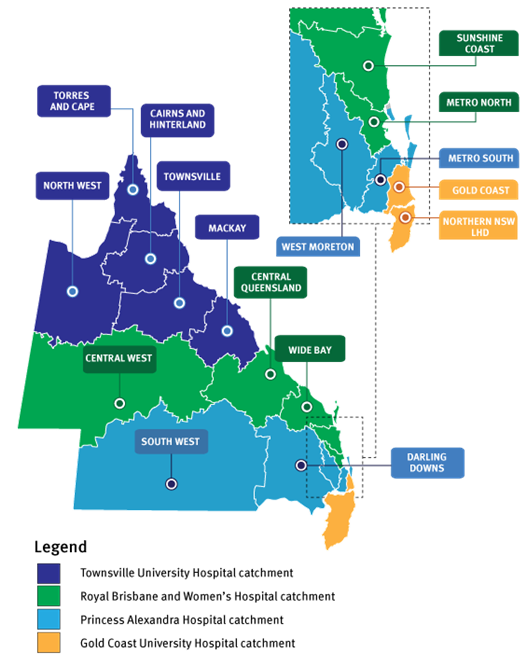
5.3. Prehospital and retrieval referrals
5.3.1. Queensland Ambulance Service (QAS) referrals - If a patient requires an emergency trauma road transfer, contact QAS on triple zero (000) without delay.
5.3.2. Retrieval Services Queensland (RSQ) referrals - If a patient requires an emergency aeromedical interhospital transfer, contact RSQ on 1300 799 127. The early notification of trauma guidelines(3) should be followed for notification of trauma for interfacility transfer for all trauma patients.
5.3.3. Royal Flying Doctor Service (RFDS) referrals - Some remote areas may have a local procedure for contacting the Royal Flying Doctors Service (RFDS) for primary transfers, and in these cases the RFDS can be contacted directly on 1300 697 337, and RFDS will advise RSQ of the details and requirements for transfer.(4)
5.3.4. Northern NSW LHD referrals -If a patient requires an emergency trauma road transfer, contact the NSW Ambulance on triple zero (000) immediately. The NSW Ambulance also incorporates the Aeromedical Control Centre (ACC), which can be contacted on 1800 650 004 for any helicopter or fixed wing transfers.
5.4. Specialist services
Statewide and specialist services may be provided at designated hospitals and have exclusive referral pathways.
5.4.1. Burns trauma - All emergency burns referrals should be sent to the Professor Stuart Pegg Adult Burns Centre, located at the RBWH. The referral criteria should be used, along with the emergency patient transfer form.
5.4.2. Acute spinal trauma – All patients with complex or unstable spinal injuries without known neurological deficits that may require emergency surgical intervention should be referred to one of the four adult major trauma centres, Sunshine Coast University Hospital or Cairns Hospital.
5.4.3. Acute spinal cord injuries - All patients with known spinal cord injuries that require urgent acute surgical management should be transferred directly to the PAH or RBWH for management; an early referral to the Queensland Spinal Cord Injuries Unit is recommended. The Spinal Injuries Unit referral and ASIA form should be utilised to ensure the required documentation is submitted to support the intake process for the Queensland Spinal Injuries Unit rehabilitation service.
5.4.4. Obstetric and neonatal trauma - All emergency antenatal and postnatal retrievals should follow the Neonatal Stabilisation for Retrieval clinical guideline and flowchart.(5) This includes the indications for transfers, referral process and preparation for retrieval checklist.
5.4.5. For single-system major traumatic injuries, the appropriate speciality team should be contacted directly to discuss the patient transfer. A full list of specialty services at each of the major trauma centres is outlined in Table 1.
Table 1: Major trauma centre specialist services
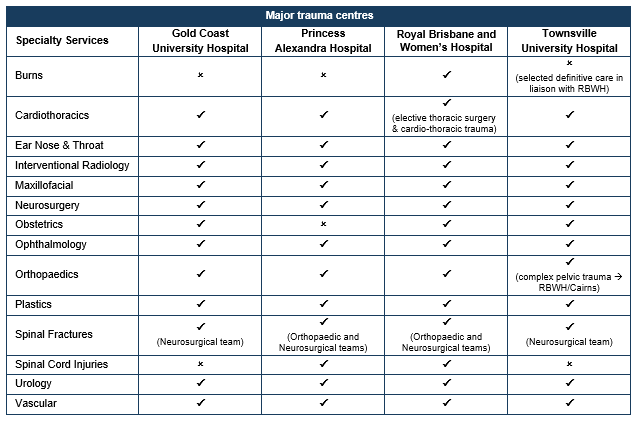
5.5. Single point of contact
5.5.1. A single point of contact at each facility is essential to minimise transfer delays and facilitate patient access to the required specialty care.
5.5.2. This direct line of communication for retrieval teams and clinicians at referring sites before, during and following transfers can minimise delays.
5.5.3. The Protocol for Timely Transfer of Care in Emergency Departments(6) states that each HHS will have senior staff support 24 hours a day for management of access issues.
5.5.4. For multi-system major trauma, a single point of contact has been nominated by each regional and major trauma centre, as listed in Appendix 2.
5.5.5. These contact points are only applicable when multiple specialties are required and for cases with single specialty involvement, the relevant specialty should be contacted directly.
5.6. Transfer considerations
5.6.1. Bariatric patients - special consideration needs to be given for any patient over 120kg due to the size and weight restrictions of transport modalities. This information must be conveyed at the earliest point of communication to allow appropriate asset tasking and equipment availability. In addition, the receiving hospital will require early notification of the patient weight status to ensure adequate preparation time to arrange the equipment and environmental setup required to provide optimal patient care.
5.6.2. Futility of care - at times, catastrophic, life limiting injuries may require a palliation pathway at the referring hospital, rather than transferring a patient to a major trauma centre. This will ensure the patient is provided optimal end of life care and their family receive the specialist clinical advice required. This may involve one or more telehealth consultations between consultants at both the major trauma centre and local facility, and involve multidisciplinary clinicians working in emergency, trauma, intensive care and surgical services. Family meetings may be conducted locally or via telehealth also, with the additional support of clinicians at the major trauma centre assisting the local onsite clinical team. The multifacility discussion and support aims to not only support clinicians, patients and family members, but should result in an agreed, clearly documented plan of care.
5.6.3. Non-urgent care - transporting the major trauma patient for non-urgent trauma care, such as secondary procedures or single system injuries also involves complex coordination and decision making. The Protocol for Management of Inter-Hospital Transfers(7) defines the process for transfer of patients into, out of and between Queensland Health hospitals. All patient transfers for non-urgent care should follow the Protocol above and are not in scope for this document.
5.6.4. Transfer back to referring hospital - the referring hospital should facilitate the patient return once definitive care has been provided at the major trauma centre.(7) The regional and rural hospitals may be the step-down journey for the patient, according to ongoing care needs, equipment requirements and skills and expertise of local clinicians. The availability of local rehabilitation services, scheduled telehealth sessions, community follow up and involvement of non-government/private organisations may play a role in this planning process.
5.7. Communication and coordination
5.7.1. Effective communication and coordination are vital to ensure a safe, effective and appropriate interfacility transfer of a major trauma patient.
5.7.2. Ensuring the responsibilities of the referring and receiving facilities are adhered to will assist with the transfer process and aligns with the Protocol for Management of Inter-Hospital Transfers.(7)
5.7.3. A localised flowchart may assist with internal and external communications to the various departments within a hospital in both major trauma centres and regional centres (Figure 2).
Figure 2: Communication flowchart
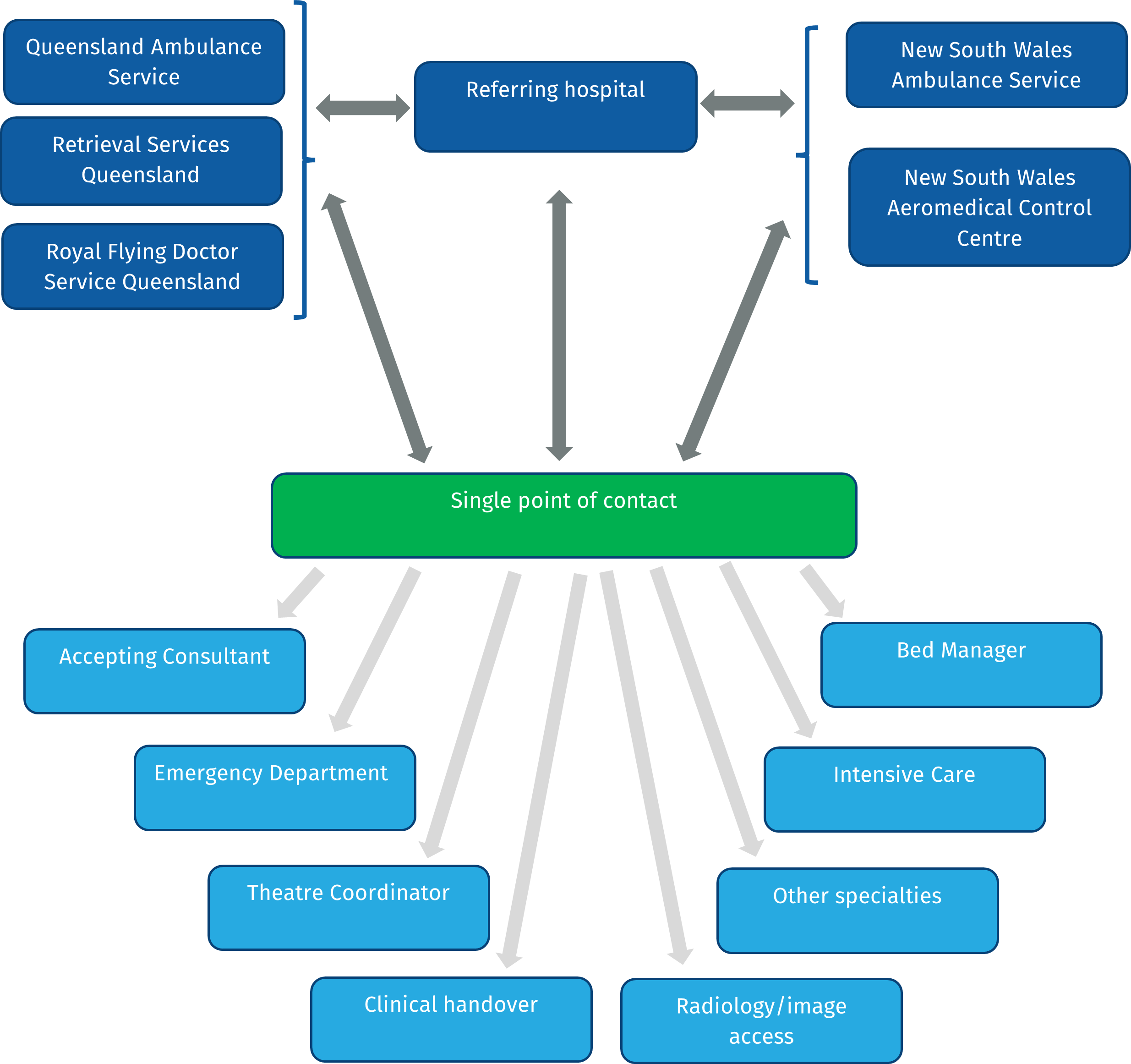
5.8. Responsibilities of referring facility
5.8.1. Early notification of the clinical situation to RSQ and/or QAS are vital to avoid transfer delays.
5.8.2. A consultant from the referring facility must ensure the referral has been discussed with a consultant at the receiving facility and agreement on the planned transfer has occurred.
5.8.3. In absence of a consultant being immediately available, the most senior clinician on duty would be appropriate.
5.8.4. Alternatively, if a determination is made by RSQ for an urgent time critical transfer, the Medical Coordinator at RSQ may assist in this process.(8)
5.8.5. Once the patient has a transfer location, the electronic Interhospital Transfer request form should be completed, and local health service advice and referral procedures should be followed.
5.8.6. All clinical information should be made readily available to the receiving facility as soon as possible, including verbal handovers, copies of clinical documentation, electronic images/reports and pathology results.
5.8.7. A transfer checklist may be useful to support this process, as illustrated in Appendix 34 for aeromedical retrievals, and Appendix 4 for road transfers.(9)
5.9. Responsibilities of receiving facility
5.9.1. The receiving facility must ensure a local coordinated response is undertaken to ensure the patient will have rapid access to the definitive care needed. This may include activation of a local trauma call, notification to emergency, intensive care, theatres, subspecialty clinical teams, radiology, and bed managers.
5.9.2. All facilities should be familiar with local processes when receiving a critically ill major trauma patient to ensure readiness of the receiving facility.
5.9.3. Transfers of critically ill patients are not to be delayed due to bed availability.(7, 10)
5.9.4. On completion of definitive care delivery and when clinically appropriate, the receiving facility must coordinate the non-urgent transfer back to the referring facility for ongoing healthcare according to local processes.
5.10. Escalation pathway and risk management
5.10.1. In the event that escalation is required for a patient transfer, consultation must occur between the referring consultant, receiving consultant, and bed manager.
5.10.2. If still unresolved, this should be escalated to the senior staff support nominated within the hospital for management of bed access issues.(6)
5.10.3. RSQ can assist with the escalation of patient care and transfers, through third party advocation and/or teleconferencing with relevant stakeholders.
5.10.4. QAS are also able to assist with escalating access to emergency departments. The QAS graduated escalation procedure is illustrated in Figure 3:
Figure 3: QAS escalation levels
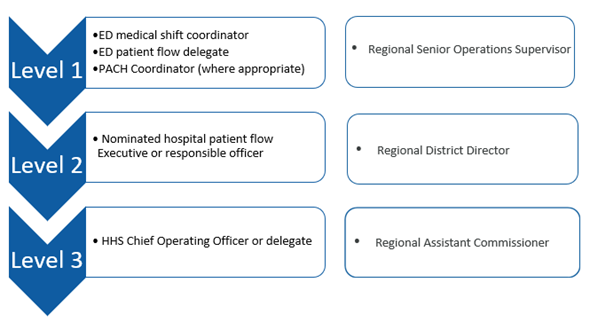
6. Abbreviations
| Abbreviation | Meaning |
|---|---|
| ACC | Aeromedical Control Centre |
| ASU | Acute Surgical Unit |
| CSCF | Clinical Services Capability Framework |
| GCUH | Gold Coast University Hospital |
| HARU | High Acuity Response Unit |
| HHS | Hospital and Health Service |
| ICU | Intensive Care Unit |
| ISS | Injury Severity Score |
| NNSWLHD | Northern NSW Local Health District |
| PACH | Patient Access and Coordination Hub |
| PAH | Princess Alexandra Hospital |
| QAS | Queensland Ambulance Service |
| QCH | Queensland Children’s Hospital |
| RACS | Royal Australasian College of Surgeons |
| RBWH | Royal Brisbane and Women’s Hospital |
| RFDS | Royal Flying Doctor Service |
| RSQ | Retrieval Services Queensland |
| TUH | Townsville University Hospital |
7. Document approval details
Document custodian
Michael Zanco, Executive Director, Healthcare Improvement Unit, Clinical Excellence Queensland
Approval officer
Jody Paxton, Director, Healthcare Improvement Unit, Clinical Excellence Queensland
8. Version control
| Version | Date | Comments |
|---|---|---|
| 1.0 | 24 January 2023 | New guideline created by Queensland Trauma Clinical Network. |
9. Acknowledgements
Clinical Guideline Leads
- Michelle Jeffress, Queensland Trauma Coordinator, Queensland Health
- Martin Wullschleger, Director Trauma, Royal Brisbane and Women’s Hospital, Chair Queensland Trauma Clinical Network
- Alistair Hamilton, Emergency Consultant, Toowoomba Hospital
- Clinton Gibbs, Clinical Director, Retrieval Services Queensland
- Jacob O’Gorman, Queensland Aeromedical Lead, Royal Flying Doctor Service
- Joseph Sharpe, Trauma Clinical Nurse Consultant, Townsville University Hospital
- Tony Hucker, Senior Paramedic, Queensland Ambulance Service
Content Contribution
- Bill Lukin, Palliative Care Consultant, Royal Brisbane and Women’s Hospital
- Brett Hoggard, Medical Director, Retrieval Services Queensland
- Mark Elcock, Executive Director, Retrieval Services Queensland
- Queensland Rural and Remote Clinical Network
Consultation
- Hospital and Health Service Chief Executives
- Queensland Trauma Clinical Network
- Queensland Emergency Department Strategic Advisory Panel
- Queensland Intensive Care Clinical Network
- Queensland Rehabilitation Clinical Network
- Queensland Rural and Remote Clinical Network
- Statewide Anaesthesia and Perioperative Care Clinical Network
- Surgical Advisory Committee
- Major Trauma Centre Directors
- Regional Trauma Services
- Emergency Department Directors
- Surgical Department Directors
- Intensive Care Directors and Nurse Managers
- Queensland Spinal Cord Injuries Service, Princess Alexandra Hospital
- Queensland Ambulance Service
- Retrieval Services Queensland
- Royal flying Doctor Service
- Northern New South Wales Local Health District and retrieval services
10. References
1. Queensland_Health. Patient access to care Health Service Directive Version 4.0 2021 [Available from: https://www.health.qld.gov.au/system-governance/policies-standards/health-service-directives/patient-access-to-care.
2. Viel IL, Moura BRS, Martuchi SD, de Souza Nogueira L. Factors Associated With Interhospital Transfer of Trauma Victims. J Trauma Nurs. 2019;26(5):257-62.
3. Retrieval_Services_Queensland. Early notification of trauma guidelines 2022 [Available from: https://qheps.health.qld.gov.au/__data/assets/pdf_file/0034/2780746/RG1001-Early-Notification-of-Trauma-Guidelines.pdf.
4. Rural_and_Remote_Clinical_Support_Unit QH. Primary Clinical Care Manual 2022 [11th:[Available from: https://www.health.qld.gov.au/rrcsu/clinical-manuals/primary-clinical-care-manual-pccm.
5. Queensland_Clinical Guidelines QH. Neonatal stabilisation for retrieval Version 4 2018 [Available from: https://www.health.qld.gov.au/__data/assets/pdf_file/0017/144026/g-stabil.pdf.
6. Queensland_Health. Protocol for timely transfer of care in emergency departments Version 1.0 2021 [Available from: https://www.health.qld.gov.au/system-governance/policies-standards/health-service-directives/patient-access-to-care/protocol-for-timely-transfer-of-care-in-emergency-departments.
7. Queensland_Health. Protocol for management of inter-hospital transfers Version 1.0 2021 [Available from: https://www.health.qld.gov.au/system-governance/policies-standards/health-service-directives/patient-access-to-care/protocol-for-management-of-inter-hospital-transfers.
8. Queensland_Health. Retrieval Services Health Service Directive Version 3.0 2022 [Available from: https://www.health.qld.gov.au/system-governance/policies-standards/health-service-directives/retrieval-services.
9. Queensland_Health. Emergency Department Safe Well organised Inter-Facility Transfer (SWIFT) Check. 2021.
10. Queensland_Health. Protocol for managing capacity of Queensland Public Hospitals Version 1.0 2021 [Available from: https://www.health.qld.gov.au/system-governance/policies-standards/health-service-directives/patient-access-to-care/protocol-for-managing-capacity-of-queensland-public-hospitals.
11. Australian_Bureau_of_Statistics. National, state and territory populations 2021 [Available from: https://www.abs.gov.au/population.
12. Shackford SR, Mackersie RC, Hoyt DB, Baxt WG, Eastman AB, Hammill FN, et al. Impact of a trauma system on outcome of severely injured patients. Arch Surg. 1987;122(5):523-7.
13. Cameron P, Dziukas L, Hadj A, Clark P, Hooper S. Major trauma in Australia: a regional analysis. J Trauma. 1995;39(3):545-52.
14. McDermott FT, Cordner SM, Tremayne AB. Evaluation of the medical management and preventability of death in 137 road traffic fatalities in Victoria, Australia: an overview. Consultative Committee on Road Traffic Fatalities in Victoria. J Trauma. 1996;40(4):520-33; discussion 33-5.
15. Zalstein S, Danne P, Taylor D, Cameron P, McLellan S, Fitzgerald M, et al. The Victorian major trauma transfer study. Injury. 2010;41(1):102-9.
16. Gough BL, Painter MD, Hoffman AL, Caplan RJ, Peters CA, Cipolle MD. Right Patient, Right Place, Right Time : Field Triage and Transfer to Level I Trauma Centers. Am Surg. 2020;86(12):1697-702.
17. Sampalis JS, Denis R, Frechette P, Brown R, Fleiszer D, Mulder D. Direct transport to tertiary trauma centers versus transfer from lower level facilities: impact on mortality and morbidity among patients with major trauma. J Trauma. 1997;43(2):288-95; discussion 95-6.
18. Garwe T, Cowan LD, Neas B, Cathey T, Danford BC, Greenawalt P. Survival benefit of transfer to tertiary trauma centers for major trauma patients initially presenting to nontertiary trauma centers. Acad Emerg Med. 2010;17(11):1223-32.
19. Deane SA, Gaudry PL, Woods WP, Read CM, McNeil RJ. Interhospital transfer in the management of acute trauma. Aust N Z J Surg. 1990;60(6):441-6.
20. Danne P, Brazenor G, Cade R, Crossley P, Fitzgerald M, Gregory P, et al. The major trauma management study: an analysis of the efficacy of current trauma care. Aust N Z J Surg. 1998;68(1):50-7.
21. Flabouris A, Hart GK, George C. Outcomes of patients admitted to tertiary intensive care units after interhospital transfer: comparison with patients admitted from emergency departments. Crit Care Resusc. 2008;10(2):97-105.
22. Choi J, Carlos G, Nassar AK, Knowlton LM, Spain DA. The impact of trauma systems on patient outcomes. Curr Probl Surg. 2021;58(1):100840.
23. Nathens AB, Jurkovich GJ, Cummings P, Rivara FP, Maier RV. The effect of organized systems of trauma care on motor vehicle crash mortality. JAMA. 2000;283(15):1990-4.
24. Nathens AB, Jurkovich GJ, Rivara FP, Maier RV. Effectiveness of state trauma systems in reducing injury-related mortality: a national evaluation. J Trauma. 2000;48(1):25-30; discussion -1.
25. Celso B, Tepas J, Langland-Orban B, Pracht E, Papa L, Lottenberg L, et al. A systematic review and meta-analysis comparing outcome of severely injured patients treated in trauma centers following the establishment of trauma systems. J Trauma. 2006;60(2):371-8; discussion 8.
26. Shafi S, Nathens AB, Elliott AC, Gentilello L. Effect of trauma systems on motor vehicle occupant mortality: A comparison between states with and without a formal system. J Trauma. 2006;61(6):1374-8; discussion 8-9.
27. Twijnstra MJ, Moons KG, Simmermacher RK, Leenen LP. Regional trauma system reduces mortality and changes admission rates: a before and after study. Ann Surg. 2010;251(2):339-43.
28. Peleg K, Aharonson-Daniel L, Stein M, Kluger Y, Michaelson M, Rivkind A, et al. Increased survival among severe trauma patients: the impact of a national trauma system. Arch Surg. 2004;139(11):1231-6.
29. Gabbe BJ, Simpson PM, Sutherland AM, Wolfe R, Fitzgerald MC, Judson R, et al. Improved functional outcomes for major trauma patients in a regionalized, inclusive trauma system. Ann Surg. 2012;255(6):1009-15.
30. Queensland_Ambulance_Service. Clinical practice guidelines: Trauma/Prehospital truma by-pass. 2021 [Available from: https://www.ambulance.qld.gov.au/docs/clinical/cpg/CPG_Pre%20hospital%20trauma%20bypass.pdf.
31. Queensland_Ambulance_Service. Digital Clinical Practice Manual 2022 [Available from: https://www.ambulance.qld.gov.au/clinical.html.
32. New_South_Wales_Ambulance_Service. Protocol: T1 Prehospital managment of major trauma. 2018.
Appendix 1: Queensland Trauma System - Background information
Queensland is the second largest state in geographical area in Australia, and covers over 1.7 million square kilometres, including over 900 islands.(11) The population of over 5.2 million is the most decentralised in Australia, with over half of residents living outside of the greater Brisbane metropolitan area. This diverse population spread can generate challenges in accessing specialist healthcare services, particularly for the critically injured trauma patient. Timely, safe, and streamlined transfers are essential to provide the definitive care and optimise patient outcomes in major trauma. Australian and international evidence supports transfer to the highest level of trauma centre directly when required for improved patient outcomes.(12-16)A worse prognosis has been demonstrated for major trauma patients re-transferred compared to directly transferred to a major trauma centre.(17, 18) Delays in patient transfer have been shown to lead to preventable and potentially preventable adverse outcomes.(14, 19, 20) Evidence also suggests multitrauma patients have a higher mortality and increased length of stay when they have been transferred in from another Intensive Care Unit (ICU) compared with patients directly admitted from the emergency department to the ICU.(21) The Queensland trauma system encompasses a multitude of services that all link together to provide trauma care delivery. Guidance on referring and transferring adult major trauma patients to a facility for higher level specialist care is contained within the referral pathways guideline for major trauma (adult).
Queensland Trauma System
Incorporating rural hospitals and regionalising trauma networks within trauma systems has been shown to reduce the burden of traumatic disease; and delivering trauma patient care to the extent of hospital capabilities is associated with decreased mortality rates.(22) Around the world, implementation of structured trauma systems has been shown to be effective (23-27), particularly for improved vital or functional prognosis of severe trauma patients. (24, 25, 27-29) The Queensland trauma system comprises of prehospital care providers, road and aeromedical retrievalists, as well as clinicians located in major trauma centres, regional hospitals and remote facilities. Following is an outline of the key components of the Queensland trauma system:
Prehospital Services
Queensland Ambulance Service (QAS) – The QAS is responsible for the statewide pre-hospital emergency response for major trauma and mass casualty incidents from 302 response locations. Each local area service network aligns with Queensland Health HHS geographical boundaries and there are also eight operations centres throughout Queensland that coordinate dispatch of emergency ambulance services, and coordinate interfacility transport services. The High Acuity Response Unit (HARU) provides an additional tier of clinical care by having a Critical Care Paramedic with an extended scope of practice in attendance and may have a senior doctor onboard also. The HARUs are based in Brisbane and the Gold Coast.
The QAS trauma/pre-hospital trauma bypass clinical practice guideline(30) outlines vital signs, mechanisms and injury patterns that direct the clinicians to transport to the nearest major trauma service (if within 60 minutes road transport time). The procedure outlines alternate processes if the major trauma centre is further than 60 minutes away, including presentation to a regional or local hospital, or contacting RSQ for aeromedical coordination. The public hospital matrix is contained within the QAS digital clinical practice manual.(31)
Retrieval Services Queensland (RSQ) – RSQ provides centralised, statewide coordination and tasking of all aeromedical transfers from Northern NSW to the Torres Strait. Specialist medical and nursing coordinators support the clinical management of the patients by providing expert advice and linking clinicians to specialists via telehealth. RSQ delivers specialist education and training to rural and remote emergency departments and supports clinicians with preparation for aeromedical transfers. The integrated network of rotary wing, fixed wing and jet services from government and non-government providers facilitates transport of both adult and paediatric patients. RSQ integrates with the State Disaster Coordination Centre to manage major incident response and mass casualty situations.
NSW Ambulance Service – The NSW Ambulance coordinates all road and aeromedical retrievals. The Aeromedical Control Centre (ACC) is located in Sydney and operated by the NSW Ambulance. The ACC contains a ‘Rapid Launch Trauma Coordinator’ who monitors all triple zero calls and provides early notification for specialist resources to be dispatched to major trauma patients. The Protocol: T1(32) for prehospital management of major trauma will be utilised by paramedics when making transfer decisions. The Aeromedical and Medical Retrieval Service is staffed by paramedics, critical care nurses and senior critical care doctors who triage patients, provide clinical advice and coordinate specialist retrieval teams by road, helicopter, or fixed wing aircraft. Helicopter retrievals in the Northern NSW LHD are primarily tasked to the Westpac Rescue Helicopter, which operates from its Lismore base, and the ACC will liaise with the RSQ Medical Coordinator regarding the transfer destination.
Major Trauma Centres
A major trauma centre provides expert definitive care to patients who have suffered major trauma. The entire spectrum of care from the initial resuscitation, through to surgical intervention, intensive care, ward-based care, and rehabilitation can be managed onsite. There are multiple specialist services within major trauma centres, and some may have a attained a designated level one trauma verification from the Royal Australasian College of Surgeons (RACS). Major trauma centres can provide clinical advice, transfer decision making and risk mitigation prior to transfer. These centres may contain one of the statewide specialty services and would typically have attained a level five or six on the Trauma Clinical Services Capability Framework (CSCF).
Regional Trauma Hospitals
A regional trauma centre manages most patients who have presented with minor to moderate trauma and may have one or more specialist services onsite. Definitive care for some selected major trauma patients may be provided, and regional centres may liaise directly with their nearest major trauma centre for consultation and transfer advice. Regional trauma centres can stabilise the major trauma patient prior to their transfer to a major trauma centre and are typically a level three or four on the Trauma CSCF.
Rural and Remote Facilities
Rural and remote facilities play a crucial role providing care for patients with trauma of any severity in their communities and are often the first point of contact for trauma cases. Many rural and remote facilities can definitively manage minor trauma without on-referral. For severe trauma cases, where local established escalation processes require patients to be transferred on, rural and remote clinicians provide notification to the referral centre and retrieval service, whilst simultaneously providing the initial care and resuscitation necessary to maintain the stability of the patient until they can reach definitive care. These facilities would typically be a level one or two on the Trauma CSCF.
Appendix 2: Single contact points for rural and regional facilities and major trauma centres
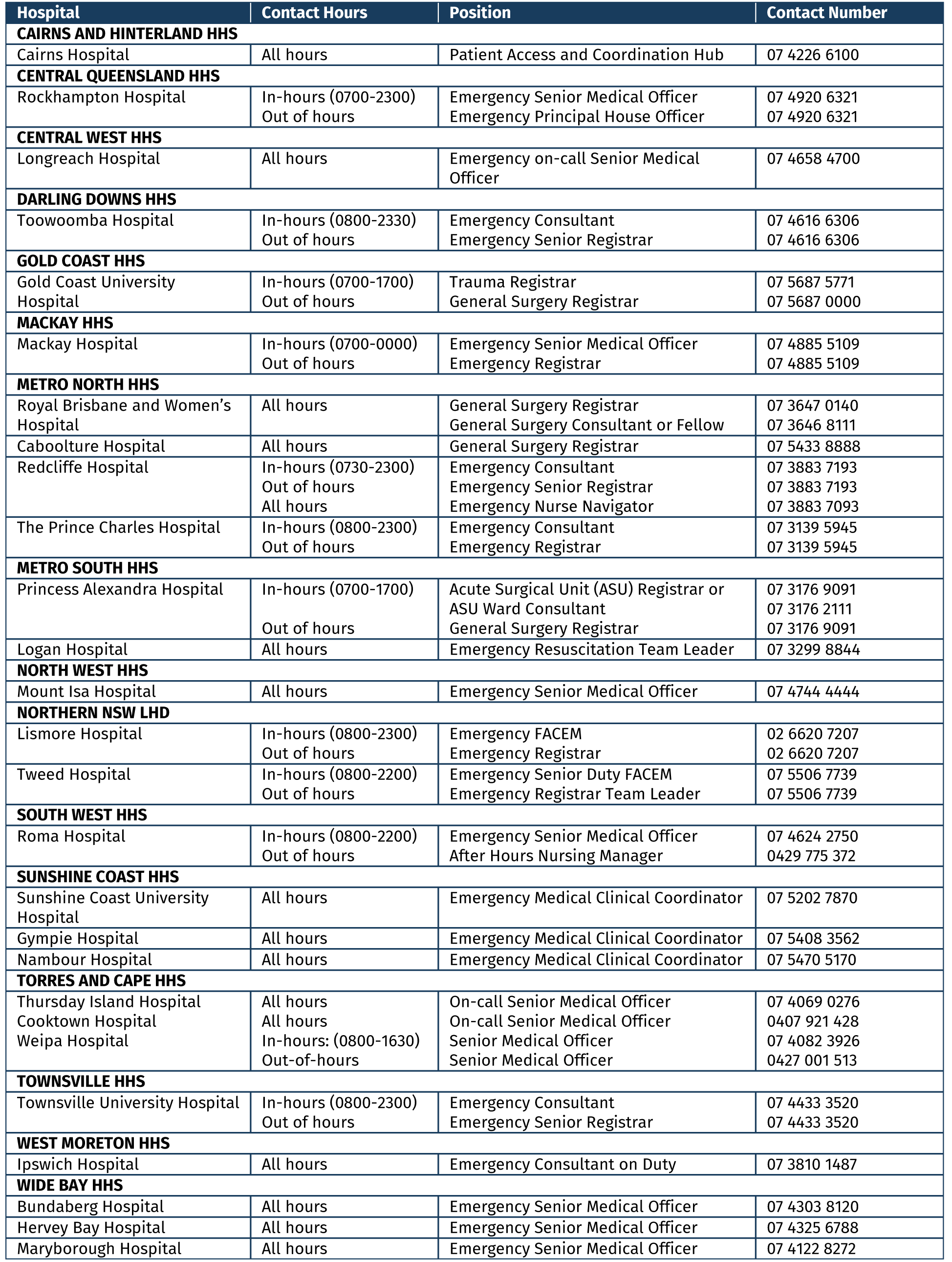
Appendix 3: RFDS Aeromedical Retrieval Checklist
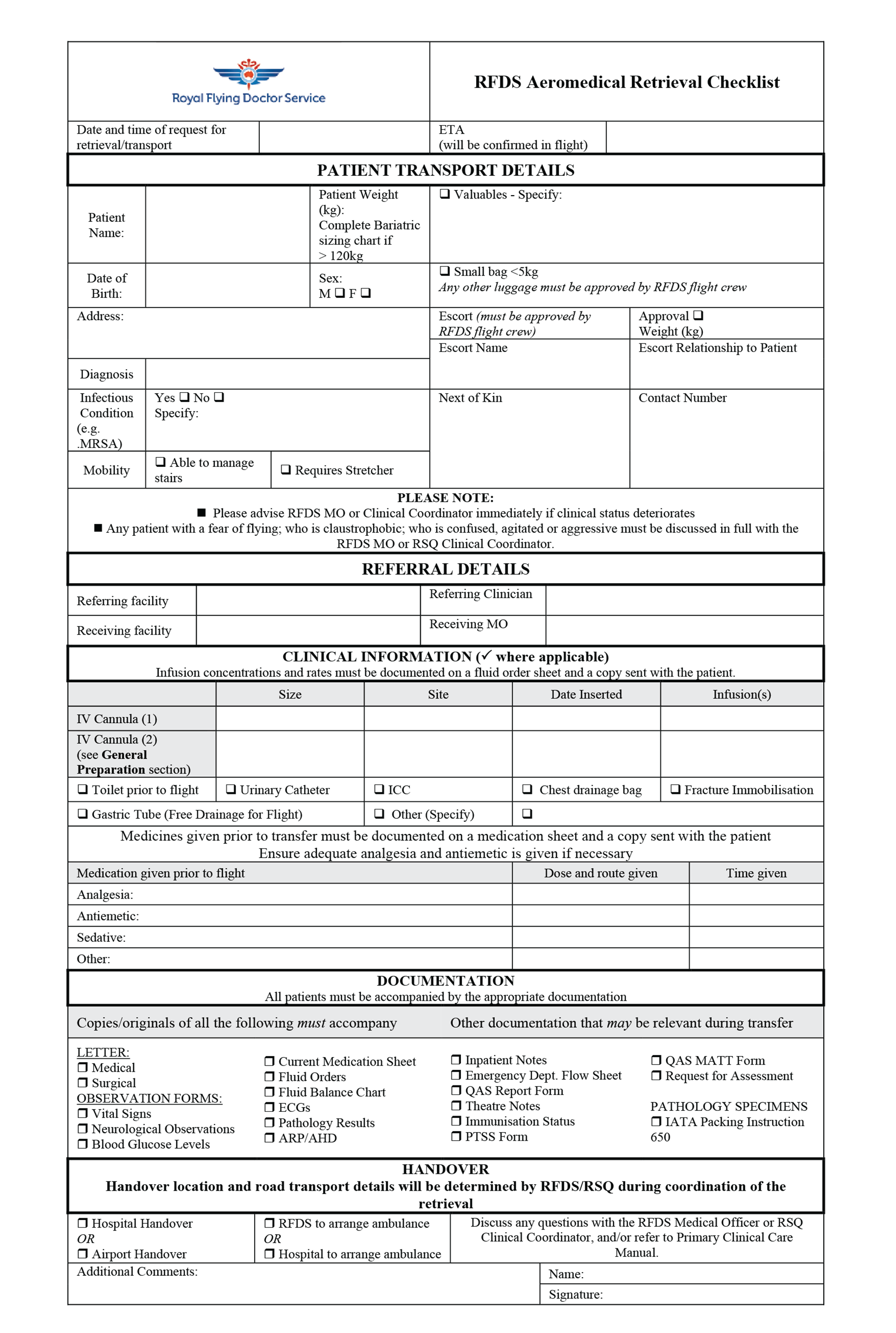
Appendix 4: SWIFT Check form
